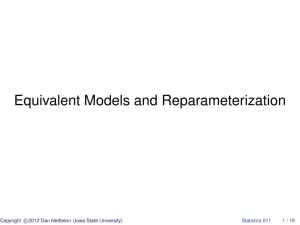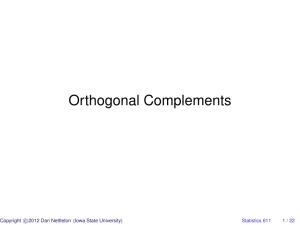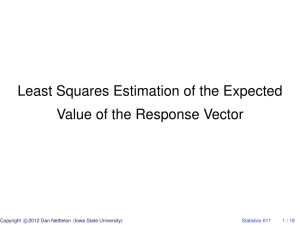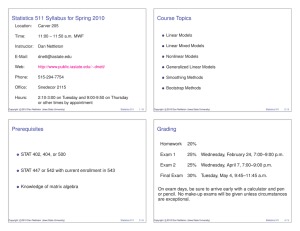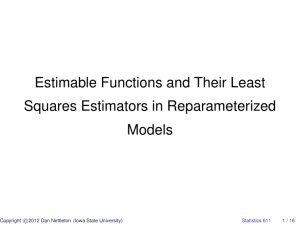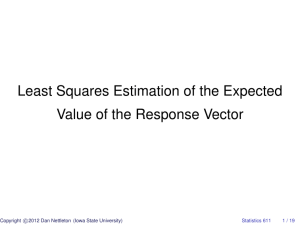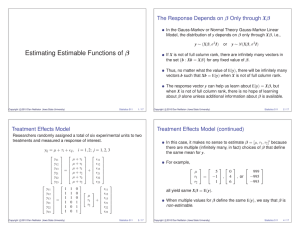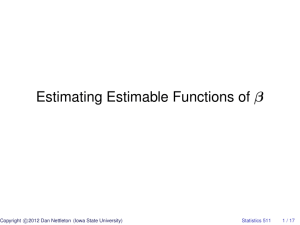Document 10639911
advertisement
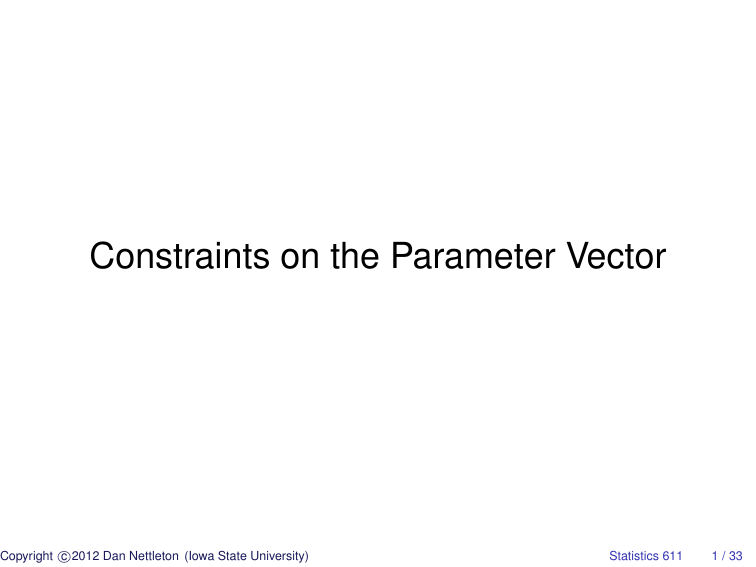
Constraints on the Parameter Vector
c
Copyright 2012
Dan Nettleton (Iowa State University)
Statistics 611
1 / 33
Suppose
y = Xβ + ε,
where E(ε) = 0 and β ∈ Rp satisfies H0 β = h for some known p×q
H of
rank q and some known h.
q×1
c
Copyright 2012
Dan Nettleton (Iowa State University)
Statistics 611
2 / 33
Given that we know β satisfies H0 β = h, what functions c0 β are
estimable, and how do we estimate them?
c
Copyright 2012
Dan Nettleton (Iowa State University)
Statistics 611
3 / 33
A linear estimator d + a0 y is unbiased for c0 β in the restricted model iff
E(d + a0 y) = c0 β
c
Copyright 2012
Dan Nettleton (Iowa State University)
∀ β 3 H0 β = h.
Statistics 611
4 / 33
c0 β is estimable in the restricted model iff ∃ a linear estimator d + a0 y 3
E(d + a0 y) = c0 β
∀ β satisfying H0 β = h,
i.e., iff ∃ a linear estimator that is unbiased for c0 β in the restricted
model.
c
Copyright 2012
Dan Nettleton (Iowa State University)
Statistics 611
5 / 33
Result 3.7:
In the restricted model, d + a0 y is unbiased for c0 β iff
∃ l 3 c = X0 a + Hl
c
Copyright 2012
Dan Nettleton (Iowa State University)
and d = l0 h.
Statistics 611
6 / 33
Proof of Result 3.7:
(⇐=) Suppose
∃ l 3 c = X0 a + Hl
and d = l0 h.
Then
E(d + a0 y) = l0 h + a0 Xβ
= l0 H0 β + a0 Xβ
∀ β 3 H0 β = h
= (l0 H0 + a0 X)β
∀ β 3 H0 β = h
= (X0 a + Hl)0 β
∀ β 3 H0 β = h
= c0 β
c
Copyright 2012
Dan Nettleton (Iowa State University)
∀ β 3 H0 β = h.
Statistics 611
7 / 33
(=⇒) First note that
{β : H0 β = h} = {(H0 )− h + (I − (H0 )− H0 )z : z ∈ Rp }
= {b∗ + Wz : z ∈ Rp },
where b∗ = (H0 )− h is one particular solution to H0 β = h and
C(W) = N (H0 ) by Results A.12 and A.15, respectively.
c
Copyright 2012
Dan Nettleton (Iowa State University)
Statistics 611
8 / 33
Now suppose
E(d + a0 y) = d + a0 Xβ = c0 β
∀ β 3 H0 β = h.
This is equivalent to
d + a0 X(b∗ + Wz) = c0 (b∗ + Wz)
∀ z ∈ Rp
⇐⇒ d + a0 Xb∗ − c0 b∗ + (a0 X − c0 )Wz = 0
⇐⇒ d + a0 Xb∗ − c0 b∗ = 0 and
c
Copyright 2012
Dan Nettleton (Iowa State University)
∀ z ∈ Rp
W 0 (X0 a − c) = 0
by Result A.8.
Statistics 611
9 / 33
Now W 0 (X0 a − c) = 0 implies that
X0 a − c ∈ N (W 0 ) = C(W)⊥
= N (H0 )⊥
= C(H).
∴ ∃ m 3 Hm = X0 a − c
⇒ ∃ m 3 c = X0 a − Hm
⇒ ∃ l 3 c = X0 a + Hl.
(l = −m.)
c
Copyright 2012
Dan Nettleton (Iowa State University)
Statistics 611
10 / 33
Now
d + a0 Xb∗ − c0 b∗ = 0 ⇒ d = c0 b∗ − a0 Xb∗
c
Copyright 2012
Dan Nettleton (Iowa State University)
= (X0 a + Hl)0 b∗ − a0 Xb∗
= l0 H0 b∗ + a0 Xb∗ − a0 Xb∗
= l 0 H 0 b∗
= l0 h.
Statistics 611
11 / 33
Recall that in the unrestricted case, c0 β is estimable iff c ∈ C(X0 ).
Result 3.7 says that c0 β is estimable in the restricted case iff
c ∈ C([X0 , H]).
c
Copyright 2012
Dan Nettleton (Iowa State University)
Statistics 611
12 / 33
Thus c0 β is estimable under unrestricted model ⇒ c0 β estimable under
restricted model.
However, the converse doesn’t hold.
If C(X0 ) ⊂ C([X0 , H]), ∃ functions c0 β estimable in restricted case but
nonestimable in unrestricted case.
c
Copyright 2012
Dan Nettleton (Iowa State University)
Statistics 611
13 / 33
Example:
Consider the one-way ANOVA model
E(yij ) = µ + τi
i = 1, . . . , t
and
j = 1, . . . , ni .
Show that c0 β is estimable ∀ c ∈ Rp under restriction
τ1 + · · · + τt = 0.
c
Copyright 2012
Dan Nettleton (Iowa State University)
Statistics 611
14 / 33
H=
" #
0
1
,
h = [0],
t×1
Then H0 β = h is equivalent to
Pt
i=1 τi
C([X0 , H]) = C
µ
τ1
β = . .
..
τt
= 0. We have
#!
"
10 0
I 1
t×t
= Rp ,
where p = t + 1.
Thus, c ∈ C([X0 , H]) ∀ c ∈ Rp .
c
Copyright 2012
Dan Nettleton (Iowa State University)
Statistics 611
15 / 33
"
How do we know
rank
rank
C
" #!
10
I
t×t
" #!
0
1
" #!
10
I
t×t
#
I 1
t×t
has Rp as its column space?
= t = p − 1.
= 1.
∩C
Thus, rank
10 0
" #!
0
1
= {0}.
#!
"
10 0
I 1
t×t
= rank
c
Copyright 2012
Dan Nettleton (Iowa State University)
" #!
10
I
t×t
+ rank
" #!
0
1
= p.
Statistics 611
16 / 33
Alternatively, suppose
"
10 0
I 1
t×t
#
z = 0.
Then
z1 + · · · + zp−1
z1 + zp
=0
..
.
zp−1 + zp
..
.
=0
⇒
z1 + · · · + zp−1
=0
z = · · · = z
1
p−1
= −zp
=0
⇒ z1 = · · · = zp = 0
"
#
10 0
∴
is of full-column rank.
I 1
c
Copyright 2012
Dan Nettleton (Iowa State University)
Statistics 611
17 / 33
Now suppose we consider the constraints
τ1 = τ2 = · · · = τt .
What functions c0 β are estimable in this case?
c
Copyright 2012
Dan Nettleton (Iowa State University)
Statistics 611
18 / 33
τ1 = τ2 = · · · = τt is equivalent to H0 β = h, where
00
H=
10
,
−I
h = 0,
(t−1)×(t−1)
∵ C(H) ⊆ C(X0 ),
(t−1)×1
µ
τ1
β = . .
..
τt
C(X0 ) = C([X0 , H]).
∴ same functions estimable with or without restrictions.
c
Copyright 2012
Dan Nettleton (Iowa State University)
Statistics 611
19 / 33
The Restricted Normal Equations (RNE) are
"
X0 X H
H0
c
Copyright 2012
Dan Nettleton (Iowa State University)
0
#" #
b
λ
=
" #
X0 y
h
.
Statistics 611
20 / 33
Result 3.8:
The RNE are consistent.
Proof: First show
"
X0 y
#
h
c
Copyright 2012
Dan Nettleton (Iowa State University)
∈C
"
X0
0
0
H0
#!
.
Statistics 611
21 / 33
The constraint equations are consistent and thus have a solution, say
b∗ , such that H0 b∗ = h. Thus,
"
#" #
X0 0
y
∴
0 H0
" #
X0 y
h
b∗
∈C
c
Copyright 2012
Dan Nettleton (Iowa State University)
"
=
X0 y
#
=
H 0 b∗
"
#!
X0 0
.
0 H0
"
X0 y
#
h
Statistics 611
22 / 33
Now suppose that we can show
N
"
#!
X0 X H
H0
0
⊆N
"
X
0
0
H
#!
.
Explain why this implies the RNE are consistent.
c
Copyright 2012
Dan Nettleton (Iowa State University)
Statistics 611
23 / 33
N (A) ⊆ N (B) ⇒ N (B)⊥ ⊆ N (A)⊥ by Result A.6.
Now N (B)⊥ ⊆ N (A)⊥ ⇒ C(B0 ) ⊆ C(A0 ) by Result A.5. Thus,
N
"
#!
X0 X H
H0
0
⊆N
"
X
0
0
H
c
Copyright 2012
Dan Nettleton (Iowa State University)
#!
⇒C
"
⇒
"
X0
0
0
#
H0
X0 y
h
∈C
#!
"
#!
X0 X H
⊆C
"
X0 X H
H0
H0
#!
0
0
⇒ RNE consistent.
Statistics 611
24 / 33
Now show that
N
"
#!
X0 X H
H0
c
Copyright 2012
Dan Nettleton (Iowa State University)
0
⊆N
"
X
0
0
H
#!
.
Statistics 611
25 / 33
"
Suppose
X0 X H
H0
0
#" #
v1
v2
" #
0
=
. Then
0
X0 Xv1 + Hv2 = 0
(1)
H 0 v1 = 0
(2)
and
Multiplying (1) on the left by v01 gives
v01 X0 Xv1 + v01 Hv2 = 0.
By (2), v01 H = 00 . Thus v01 X0 Xv1 = 0.
c
Copyright 2012
Dan Nettleton (Iowa State University)
Statistics 611
26 / 33
Now v01 X0 Xv1 = 0 ⇒ Xv1 = 0.
Thus, (1) becomes
X0 0 + Hv2 = 0 ⇒ Hv2 = 0.
"
∴
X
0
0
H
#" #
v1
v2
" #
0
=
, and it follows that
0
N
"
#!
X0 X H
H0
0
⊆N
"
X
0
0
H
#!
.
c
Copyright 2012
Dan Nettleton (Iowa State University)
Statistics 611
27 / 33
Result 3.9:
If β̃ is the first p components of a solution to the RNE, then β̃ minimizes
Q(b) = (y − Xb)0 (y − Xb) = ky − Xbk2
over b satisfying H0 b = h.
c
Copyright 2012
Dan Nettleton (Iowa State University)
Statistics 611
28 / 33
Proof of Result 3.9:
Suppose b is any vector satisfying H0 b = h. Then
Q(b) = ky − Xbk2
= ky − Xβ̃ + X(β̃ − b)k2
= ky − Xβ̃k2 + kX(β̃ − b)k2
+ 2(β̃ − b)0 X0 (y − Xβ̃).
c
Copyright 2012
Dan Nettleton (Iowa State University)
Statistics 611
29 / 33
1/2 the cross product is
(β̃ − b)0 X0 (y − Xβ̃).
Because β̃ satisfies RNE, we have
X0 Xβ̃ + Hλ = X0 y.
∴ X0 y − X0 Xβ̃ = Hλ.
Thus 1/2 cross product is
(β̃ − b)0 Hλ = λ0 H0 (β̃ − b)
c
Copyright 2012
Dan Nettleton (Iowa State University)
= λ0 (H0 β̃ − Hb)
= λ0 (h − h)
= 0.
Statistics 611
30 / 33
Thus, we have
Q(b) = ky − Xβ̃ + X(β̃ − b)k2
= ky − Xβ̃k2 + kX(β̃ − b)k2 .
∴ Q(β̃) ≤ Q(b) with equality iff Xβ̃ = Xb.
c
Copyright 2012
Dan Nettleton (Iowa State University)
Statistics 611
31 / 33
Result 3.10:
If β̃ satisfies
H0 β̃ = h
and Q(β̃) ≤ Q(b)
∀ b 3 H0 b = h,
then β̃ is the first p components of a solution to the RNE.
c
Copyright 2012
Dan Nettleton (Iowa State University)
Statistics 611
32 / 33
Proof of Result 3.10:
Let β ∗ denote the first p components of any solution to the RNE.
By the proof of Result 3.9, it follows that Xβ ∗ = Xβ̃. Thus
X0 y = X0 Xβ ∗ + Hλ = X0 Xβ̃ + Hλ
so that
" #
β̃
λ
solves the RNE.
c
Copyright 2012
Dan Nettleton (Iowa State University)
Statistics 611
33 / 33
